We love history and one of the regions of the world that is ripe with historical sites is Greece and Turkey. Located on the western shores on modern Turkey, Ephesus is located along the Mediterranean trade routes in ancient times. At least over 1.5 million tourists visit the area yearly.
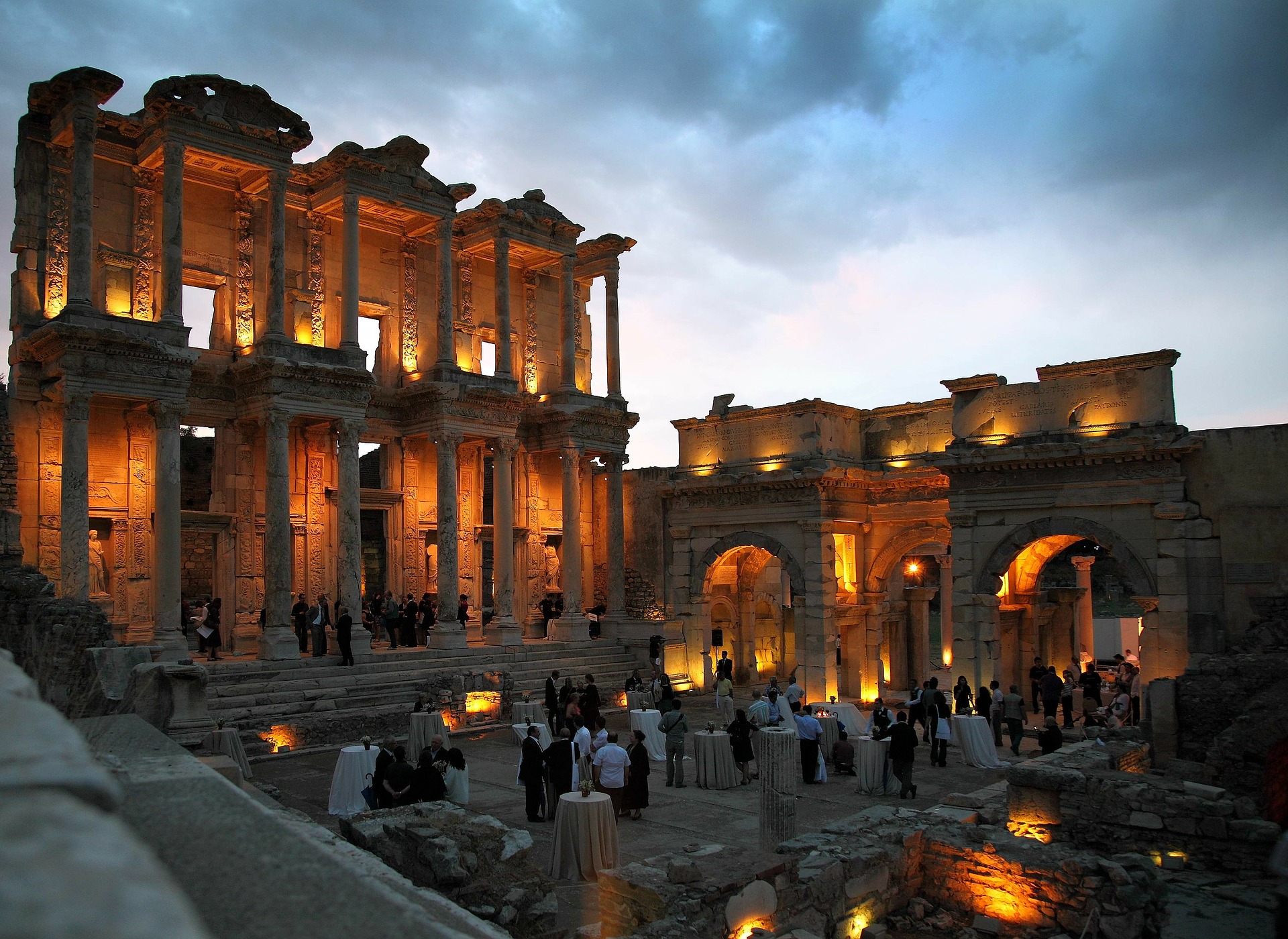
The history of Ephesus can be traced back through thousands of years. The city has survived through incredible change, as various civilizations rose and fell through the centuries. The magnificent architecture that remains from the Greco-Roman period and its other archeological wonders, makes it our 9th stop in Journeys to Discovery.
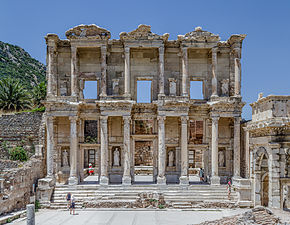 Ephesus is the most complete classical metropolis, yet 80% of the city remains buried.
Ephesus is the most complete classical metropolis, yet 80% of the city remains buried.
This proximity to the sea, allowed the city periods of prosperity, that lasted through the Classical era, the Hellenistic period, the Roman Empire, the Byzantine Empire,and finally the Ottoman Empire.
At its height the city may have been home to at least 200,000 residents, making it the fourth largest city in the Roman Empire. This would be after the cities of Rome, Alexandria and Antioch. Of course, the actual number living in the city, is still being debated among historians.
 The history of the area can be traced back to 6,000 BCE (before the common era), as is evidenced by excavations at the nearby mounds known as tells, at both Arvalya and Cukurici.
The history of the area can be traced back to 6,000 BCE (before the common era), as is evidenced by excavations at the nearby mounds known as tells, at both Arvalya and Cukurici.
According to legend, Ephesus was founded by the great female warriors known as the Amazons.
Historically, the city of Ephesus itself would be inhabited from the Bronze Age onwards. Over time, the exact location would change, due to environmental reasons and the impulses of various rulers.
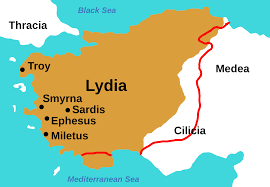 Although the Carians and Lelegians were among the first residents of the city, Ionian migrations began around 1200 BCE. The arrival of these newcomers would soon change the culture to Greek.
Although the Carians and Lelegians were among the first residents of the city, Ionian migrations began around 1200 BCE. The arrival of these newcomers would soon change the culture to Greek.
The city would be founded a second time, by the Ionian Androclus, son of Codrus.
The entire region would later be ravaged during the Cimmerian invasion, at the beginning of the 7th century BCE. However, under the rule of Lydian kings, Ephesus would soon become one of the wealthiest cities in the Mediterranean world.
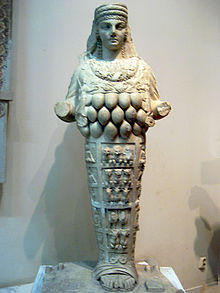
Statue of Goddess Artemis of Ephesus
It was said that during the night, the city streets were brightly lit with oil lamps. This was a extravagance that remained unaffordable, for most metropolitan areas in ancient times.
Ephesus also became a center of learning. The city was renowned for being the birthplace of the philosopher Heraclitus. It was also one of the few places for the time, where women were afforded rights equal to men.
Under the famed King Croesus of Lydia, the reconstruction of the Temple of Artemis began in 550 BCE. The first incarnation had been destroyed in a flood in the 7th century BCE.
It would take 10 years to complete, but would later by destroyed by Herostratus in an act of arson in 356 BCE. Supposedly this occurred, the same night that Alexander the Great was born.
Alexander the Great during his conquest of the region, offer to fund the completion of the famous temple.
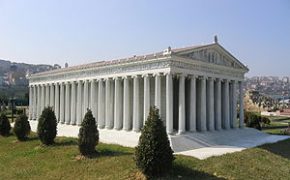
This model of the Temple of Artemis, at Miniatürk Park, Istanbul, Turkey, attempts to recreate the probable appearance of the first temple in miniature form.
The Ephesians did not take him up on the offer. They instead would finish the project years after his death in 323 BCE. It had taken decades to complete and would become one of the Seven Wonders of the Ancient World.
This Temple of Artemis was 450 feet long (137 meters) and 225 feet wide (69 meters). It was 60 feet or 18 meters high, with more than 127 enormous marble columns.
In 268 CE (common era) after 600 years of existence, the temple would be seriously damaged by the Goths.
It was restored again, but would later be destroyed by a Christian mob in 401 CE. Many of the marble stones would be recycled, in the construction of other public buildings.
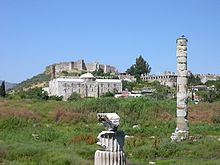
Three periods of history in Selçuk: Temple of Artemis(front), Isa Bey Mosque built by the Seljuk Turks (middle), the Byzantine castle (far)
A number of the famous columns 60 feet in height, were used in the building of the Hagia Sophia, by the Byzantine Emperor Justinian from 532 to 537 CE.
The site of the temple would be rediscovered in 1869, with most of the remains being removed and put on display in the British Museum in the Ephesus Room.
Today, the site of the temple can be found in Selcuk, which is located about 1 mile (1.6 kilometers) northeast of Ephesus. The town is known as the Gateway to Ephesus. What remains is a single column created out of further architectural remnants and several other marble fragments.
King Croesus would later be defeated, by the Persian King Cyrus. The whole of Anatolia (Asia Minor) would then become part of the growing Persian Empire. Ephesus however, remained an important port of trade.
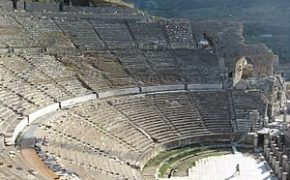
Great Theatre, seating capacity 24,000.
When the Ionian Greek city-states subsequently rose up against Persian rule in the 5th century BCE, Ephesus made the wise decision to remain neutral and thus escaped the devastation, that was levied against so many other neighboring cities.
Ephesus would subsequently remain part of the Persian realm, until being liberated by Alexander the Great in 334 BCE.
Lysimachus a general serving under Alexander, became the ruler of the region surrounding Ephesus following the death of the latter.
He immediately began the restoration and further development of the city. He did end up moving the city about two miles to the southwest, closer to the coast. This later allowed a reemergence of the city, as an important commercial center.
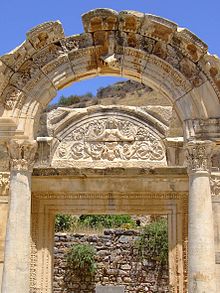
Temple of Hadrian.
In 129 BCE, the Romans would acquire Ephesus through the final testament of King Attalos of Pergamon. He bequeathed his kingdom to Rome,knowing the territory was likely to fall to them regardless.
The city would survive the rebellion of Mithridates and the storming of the city by the Roman army, under the command of Sulla in 88 BCE.
Ephesus would suffer severe damage, in the earthquake that hit the city in 17 CE.
The city would be rebuilt and would once again become an important center of commerce. It was recognized at the time, as being the most important trading center in Asia.
During the time of Augustus, Ephesus became the capital of proconsular Asia (western Asian Minor). According to Strabo the Roman historian, it was the second in importance and size only to Rome. This would mark another golden age for the city of Ephesus.
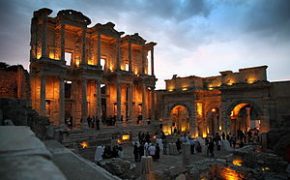
Facade of the Library of Celsus at night.
Ephesus would remain a leading intellectual center with the famous Celsus Library and the second school of philosophy in this part of the world. The library itself, once held 12,000 scrolls. It was the third largest in the ancient world, after Alexandria on the coast of Egypt and Pergamon.
Remnants of impressive architectural features of many of the buildings built during this time, are still standing.
The city would be repeatedly visited by early Christians, especially St. Paul. According to tradition, Mary the mother of Jesus, spent her later years there. Her house may still be visited today. Tourists can also visit the tomb of St. John.
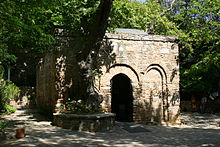
House of the Virgin Mary
The Book of the Ephesians found in the Christian Bible, was written for the people living in the area.
In later times, Ephesus laid claim to being the site of the Cave of the Seven Sleepers. It is reputed that seven Christian saints were walled up in a cave above the city, as a punishment for their faith. They would sleep for two hundred years,later emerging as proof of the power of the resurrection.
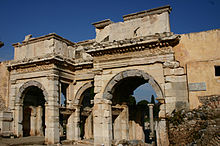
The Gate of Augustus in Ephesus was built to honor the Emperor Augustus and his family.
The city would be seriously damaged by the Goths in the 263 CE attack. This began the decline of the greatness and splendor of the city.
Roman Emperor Constantine the Great, would attempt to rebuild much of the city and did erect new public baths. However, the previous glory of the city, could not be totally recaptured.
Once Christianity became the dominant religion of the Roman Empire, the city of Ephesus would begin a further decline. Emperor Theodosius ruling in the late 300’s, had all the pagan temples closed, along with all the schools. The worship of Artemis was now forbidden.
Women would again be reduced to second class status. They would henceforth, be denied work in the arts and learning.
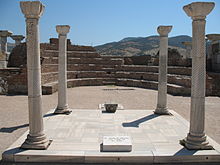
Tomb of John the Apostle at the Basilica of St. John.
The previously lighted streets, adorned with numerous statuary began to decay. Ruins of a number of great buildings, were used as a quarry for far less impressive buildings.
The Byzantine era lasted from 395 CE to 1308 CE for Ephesus. It would remain the most important city in the Byzantine Empire in Asia, after Constantinople the capital, in the 5th and 6th centuries.
The basilica of St. John was built during the reign of Justinian I in the 6th century.
Another earthquake in 614 CE again, destroyed part of the city.
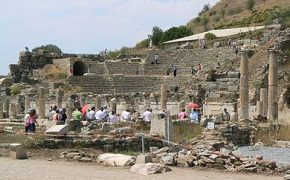
Odeon, indoor theatre once topped with a wooden roof.
The harbor was slowly being silted up the river, despite numerous dredging projects. As the access to the Aegean Sea was blocked, trade patterns changed and the city began to lose the important role, it once had held.
Residents began to migrate to the hills, from the lowlands of the city. Again the ruins of the temples, were used in the building of new structures.
Distressingly, marble sculptures would be ground down into paste, to make lime for plaster. The arrival of the Arabs between 654 CE and 655 CE saw the sacking of the city. This was repeated in 700 CE and then again in 716 CE.
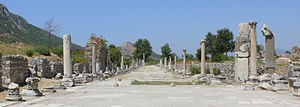
Street scene at the archaeological excavations at Ephesus.When the Seljuk Turks conquered Ephesus in 1090 CE, it was little more than a village.
When the Byzantines regained control seven years later, they even changed the name to Hagios Theologos. They would finally surrender the entire area, to the Seljuk Turks in 1308 CE.
The warriors of the Second Crusade fought the Seljuks, outside what had been in Ephesus in late 1147 CE. They were surprised at the small size of the community and how it had become cut off from the larger world. In addition, the Temple of Artemis had been long forgotten by the local people.
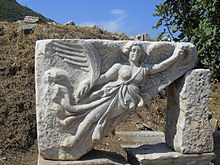
Stone carving of the goddess Nike
What had been Ephesus surrendered to the Ottoman Turks in the early 14th century. Contrary to an earlier pledge, the Turks pillaged the church of St. John and deported most of the population to Greece. Those that remained, were largely massacred during these turbulent times.
Ephesus would once again know a period a brief prosperity, later in the 1300’s. The Turks would construct the Isa Bey Mosque in the later part of the century, carvansaries and a number of Turkish bathhouses.
Next the area was incorporated as a vassal territory of the Ottoman Empire in 1390 CE. Thereafter, a period of unrest followed. Ephesus would change hands a number of times, with the defeat of the Ottomans by Tamerlane in 1402 CE.
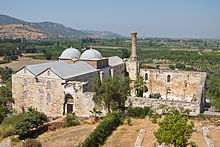
The İsa Bey Mosque constructed in 1374–75, is one of the oldest and most impressive works of architectural art remaining from the Anatolian beyliks
The Ottoman Empire would finally resume control of the region in 1425 CE. By this time, the city of Ephesus had become completely abandoned.
In addition to the aforementioned, another site to be seen today in Ephesus is the famous theater. With a seating capacity of around 24,000, it is believed to be the largest in the ancient world. In Greek times, various plays were constantly reenacted on the stage. In Roman times, these would be replaced with gladiatorial contests.
Tourists can also visit two different ancient agoras. One was used for commercial purposes, the other for official state business.
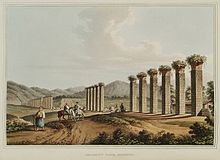
Aqueduct near Ephesus – Mayer Luigi – 1810
Ephesus is in possession of several major bath complexes, built when the city was under Roman rule.
The city was blessed, with one of the most advanced aqueduct system in the ancient world. There were at least six of them, that supplied the city with water and provided energy for a number of water mills.
The Odeon was a small roofed theater constructed around 150 CE. The ruins give visitors a more than adequate view, of what it once looked like.
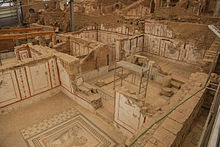
The ‘terrace houses’ at Ephesus, showing how the wealthy lived during the Roman period. Eventually the harbor became silted up, and the city lost its natural resources.
The famous Temple of Hadrian can be traced back to the 2nd century, but did undergo extensive repairs in the 4th century. What can be seen today, has been reassembled from the surviving architectural remnants. Original reliefs from the temple, can be seen in the nearby Ephesus Archaeological Museum located in Selcuk.
The Temple of the Sebastoi (Temple of Domitian) was one of the largest buildings in the city. Dedicated to the Roman Flavian Dynasty, the temple and the statue provide the historical connection, to the Emperor Domitian.
There is also the Tomb/Fountain of Pollio erected in 97 CE in honor of C. Sextilius Pollio, who constructed the Marnas aqueduct.
There are numerous other archeological remains to be visited throughout the ancient city as well.
How To Get There
Many visitors arrive by cruise ship, coming through the nearby port of Kusadasi. From there you will need to choose between a tour organized by the cruise operators or plan an independent excursion.
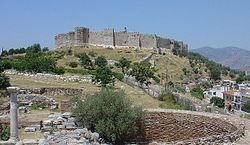
The grand Byzantine fortress of Selçuk on Ayasoluk Hill
You can then arrange to take a taxi to Selcuk, which is nearly 12 miles or 19 kilometers away. It is relatively expensive, as compared to taking a bus from Kusadasi, which is another alternative. These run about every 30 minutes.
Another option is to travel by air to the Izmir Adnan Menderes International Airport. The distance to Selcuk from here, is about 34 miles or 55 kilometers. If your hotel will be in Izmir, shuttles to Selcuk are provided at various times.
Travelers can also take a train from the airport. One can also arrive by bus from the Izmir central station.
From Selcuk one can actually walk the distance to Ephesus, since it is only 2.5 miles or 4 kilometers away. If your hotel is in Selcuk you can borrow a bike for the short trip. Most of the businesses that provide accommodation to tourists, will offer some kind of ride to Ephesus, since that is their main business.
Helpful Hints For All Travelers
The upper Magnesia gate is the better side to enter, since it allows one to walk downhill and to exit at the lower harbor gate. The entire ruins can easily be covered on foot, within two hours.
There are an assortment of souvenir shops at the two exit gates. Negotiations on price are possible. One should compare prices. However, it is not a good place to buy carpets or leather goods. These should be purchased in the larger shops in Selcuk.
See this guide on Thessaloniki, article on Milos in the Aegean Sea and our other article on Ephesus.

Marcello Arrambide considers himself a fanatical entrepreneur. During his younger years, when CD burning software first came out, he burned CD’s and sold them for $5 to $10 a piece, worked at a bakery and took the leftovers to school and sold them to students for breakfast the next morning. He flew to New York City and found a contact in China to have purses and wallets shipped him directly to sell.
He has since tried sales, real estate, software and day trading, where he coaches others to learn and develop their skill in the market. He plans to show everyone how easy living and moving overseas can be on your own terms as long as you have high speed internet and a computer.








